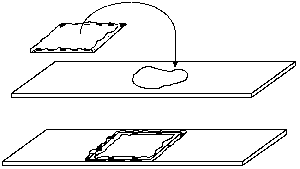Phase Contrast Microscopy
Most of the detail of living cells is undetectable in bright field microscopy because there is too little contrast between structures with similar transparency and no color. Unless the specimen mount is extremely thin, dark field mode may distort details. However the various organelles show wide variation in refractive index, that is, the tendency of the materials to bend light, providing an opportunity to distinguish them.
Highly refractive structures bend light to a much greater angle than do structures of low refractive index. The same properties that cause the light to bend also delay the passage of light by a quarter of a wavelength or so. In a light microscope in bright field mode, light from highly refractive structures bends farther away from the center of the lens than light from less refractive structures and arrives about a quarter of a wavelength out of phase.
Light from most objects passes through the center of the lens as well as to the periphery. Now if the light from an object to the edges of the objective lens is retarded a half wavelength and the light to the center is not retarded at all, then the light rays are out of phase by a half wavelength. They cancel each other when the objective lens brings the image into focus. A reduction in brightness of the object is observed. The degree of reduction in brightness depends on the refractive index of the object.
Phase contrast is preferable to bright field microscopy when high magnifications (400x, 1000x) are needed and the specimen is colorless or the details so fine that color does not show up well. Cilia and flagella, for example, are nearly invisible in bright field but show up in sharp contrast in phase contrast. Amoebae look like vague outlines in bright field, but show a great deal of detail in phase. Most living microscopic organisms are much more obvious in phase contrast.

Figure. (a) organelles are nearly invisible in bright field although they have different refractive indexes; (b) light is bent and retarded more by objects with a high refractive index; (c) in phase contrast a phase plate is placed in the light path. Barely refracted light passes through the center of the plate and is not retarded. Highly refracted light passes through the plate farther from center and is held back another one quarter wavelength.; (d) The microscope field shows a darker background (in this case the cell cytoplasm has a higher refractive index than the contractile vacuole), with the organelles in sharp contrast.
Phase contrast condensers and objective lenses add considerable cost to a microscope, and so phase contrast is often not used in teaching labs except perhaps in classes in the health professions and in some university undergraduate programs. This is unfortunate since the images obtainable in phase contrast mode can be very dramatic.
To use phase contrast the light path must be aligned. An element in the condenser is aligned with an element in a specialized phase contrast lens. This usually involves sliding a component into the light path or rotating a condenser turret. The elements are either lined up in a fixed position or are adjusted by the observer until the phase effect is optimized. Generally, more light is needed for phase contrast than for corresponding bright field viewing, since the technique is based on a diminishment of brightness of most objects.
Naegleria is a soil protist that feeds in an amoeboid form for most of its life. Under some conditions the amoeba will transform into a flagellated stage. The transformation can be observed by suspending the amoebae in water then preparing a vaseline mount of the suspension. A suspension will be provided by the instructor, but you will need to make your own Vaseline mount.
To make a Vaseline mount simply take a single cover slip and hold it between thumb and forefinger by the edges. Pick up some Vaseline on the other forefinger and rub it over your thumb to make a film. Scrape your thumb carefully on each edge of the cover slip to make a continuous vaseline ledge. Place a drop or two of suspension on a clean slide, and turn the cover slip over on top of the drop. Press down the edges to seal the chamber against evaporation.

When preparing a Vaseline mount, keep in mind that the image becomes degraded with thicker mounts, especially at high powers in dark field or phase contrast. Unless the specimen is large and fragile enough to be damaged by pressing down too hard on the cover slip, keep the chamber depth very shallow.
A wet mount of Naegleria will keep for hours. Place the slide on the stage, cover slip up, of course. Use dark field microscopy to find the focal plane at 40x using the Vaseline film or an air bubble as a target. Switch to 100x, still in dark field mode, and you should be able to focus on high contrast objects that resemble perfect circles or spheres. They will be quite small, on the order of 10 micrometers diameter, and may be clustered together like grapes. These are cysts, namely dormant amoebae surrounded by a secreted cell wall.
Focus on one or more cysts, since they are easiest to find. Switch to high dry magnification (400x) and focus. Now set up for phase contrast, using the appropriate setting for the 40x objective lens. Turn up the illumination. You should now see detail on the surface of the cysts. In addition, a little bit of scanning should turn up the amoebae, which are about the same diameter as the cysts but more irregularly shaped and moving. You can clearly see the pseudopodia, nucleus, contractile vacuole, ectoplasm, and endoplasm.
Keep the wet mount for later observation of transformation in Naegleria.